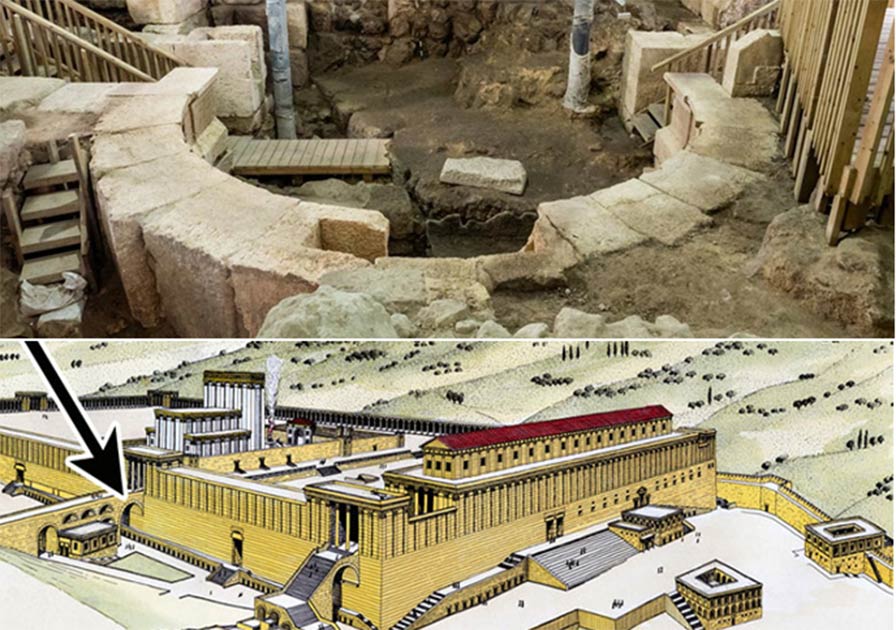Scientists Settle Wilson’s Arch Debate Pinpointing Temple Mount Origin
Historians and archaeologists have long argued about when exactly “Wilson’s Arch” in Jerusalem was built, with their estimates varying by 700 years. But now, a new cuttng-edge C14 testing method provides ‘extreme accuracy’ for the building of Wilson’s Arch. The old debate is settled by a new study of charred seeds and plant stems gathered from between the stones.
Wilson's Arch is the modern name for an ancient stone arch located at the Northeast corner of Jerusalem's Western Wall Plaza, on the left hand of visitors facing the famous Wall that once served to protect the Solomon’s Temple. The arch was first documented in 1864 by 19th-century explorer and surveyor, Sir Charles William Wilson, after whom it is now named. At that time it spanned 13 meters (42 feet) and supported a 23 meter (75 feet) long road that formed part of the former great causeway bridge that pilgrims traipsed across to reach Temple Mount.

Charles Wilson's 1871 "Recovery of Jerusalem" publication of the Ordnance Survey of Jerusalem. (Public Domain)
A Multidisciplinary Archaeological Force
The project was funded by the Israel Science Foundation and the new study by author Dr. Johanna Regev, from the Weizmann Institute of Science, is published in PLOS ONE. It aims to settle disputes over the Wilson Arch’s date of construction, which varies by about 700 years.
According to a Times of Israel article “new field-based techniques were given a test run” in an excavation conducted by the IAA ’s Uziel, Tehillah Lieberman and Dr. Avi Solomon between 2015-2019. During that time, archaeologists collected 33 charred seed and stem samples from mortar in the arch, which radiocarbon dated to between 20 BC and 20 AD, during the reign of King Herod.

Wilson's Arch excavation area.(A) Map of the old city of Jerusalem and the location Wilson's Arch (© Israel Antiquities Authority, 2020); (B) An artistic reconstruction of the Temple Mount in the time of Herod the Great (1st century AD). The arrow points to the arch known today as Wilson's Arch (© Ritmeyer Archaeological Design, 2020); (C,D) Photographs of the site. The scale bar in D is 1 meter in length. (Regev et al, 2020)
The archaeologists also found alterations had been made to the archway between 30 and 60 AD, when the holy city was ruled by Pontius Pilate, and while these works almost doubled its length, it is currently unknown why the work was undertaken.
Ironing Out the Historic Debate on Wilson’s Arch
In a Daily Mail article, Dr. Regev said we “absolutely dated monumental structures to very narrow windows of time” and it was so accurate that the team were even able to associate specific architectural features and enhancements to specific rulers. Now it is known the building of Wilson's Arch had been initiated by Herod the Great, and later it was enlarged during Roman Procurators such as Pontius Pilate, “in a range of 70 years, rather than 700 years, as previously discussed by scholars,” the researchers wrote in their paper.

A 3D reconstruction of the site. As the site is under constant renovations, a model is used here to illustrate the location of the various features and strata. A section drawing of strata 1,4,5 was imposed on the Western Wall to illustrate their relative position. (Regev et al, 2020)
Radiocarbon dating measures the amount of carbon-14 locked with ancient organic objects such as leaves, logs, animal droppings and dead animals, which is trapped while the organisms were alive. Since carbon decays predictably, archaeologists can reliably estimate ages; however, the method is not always accurate as atmospheric fluctuations differ depending on the time period and affect the decomposition of carbon.
In-field C14 Sampling, the Tightening of Time
For Boaretto, the implications of the new “in-field C14 sampling techniques” are potentially far reaching and have already revealed “an arch built by Herod, to a theater complex abandoned before it was completed as a consequence of Bar Kochba revolt”. In conclusion, Boaretto thinks the new methods of analysis will provide archaeologists and researchers of the history of Jerusalem “a fresh look at the city ’s history.” It also finally places this monumental structure, Wilson’s Arch, in its proper historical setting, which she says, “certainly helps solve this riddle,” in the Times of Israel article.
- Extremely Rare Ancient Mosaic Bearing a Greek Inscription Discovered “Miraculously” in Jerusalem
- Cave of Zedekiah: The Secret Grotto of Jerusalem
- Telling Seal Unearthed in Jerusalem Names Biblical Figure
Furthermore, Uziel says the new in-field C14 sampling technique “Will be a calling card for future studies and not just in Israel, but elsewhere,” and she hopes it will provide more precise dates for other monuments across the Eastern Mediterranean. According to the paper, radiocarbon dating is rarely applied in Classical and Post-Classical periods in the Eastern Mediterranean, as it is not currently considered precise enough to solve specific chronological questions, often causing the attribution of historic monuments to be based on circumstantial evidence. But all that has changed with in-field C14 sampling.
Top Image: Wilson's Arch excavation area and an artistic reconstruction of the Temple Mount in the time of Herod the Great (1st century AD). The arrow points to the arch known today as Wilson's Arch (© Ritmeyer Archaeological Design, 2020) Source: Regev et al, 2020
By Ashley Cowie




















Comments
From what I can recall, Solomon's temple was destroyed and another temple was built after the Babylon captivity. Then that temple burned down and was replaced by Herod. So there have been 3 temples so far even though Herod's temple is often referred to as the second temple.
Doesn't that confirm the speculation that the whole complex was built by the Romans and not Solomon?